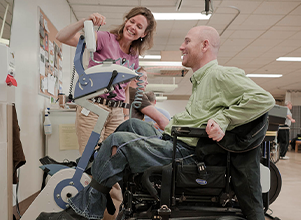Publications
Praxis is strongly committed to sharing details of the great work that is taking place throughout the SCI field. Explore SCI-related scientific papers, reports and more.

This is the breadcrumbs block. Breadcrumb will populate on actual page.
Hope Jervis Rademeyer, Cindy Gauthier, José Zariffa, Kristen Walden, Tara Jeji, Shane McCullum, Kristin E Musselman
J Spinal Cord Med. Online ahead of print (2022).
DOI: https://doi.org/10.1080/10790268.2022.2039855
Objective
To understand if and how physical therapists (PTs) and occupational therapists (OTs) use activity-based therapy (ABT) and its associated technologies for the rehabilitation of individuals living with spinal cord injury or disease (SCI/D) in Canadian rehabilitation hospital settings.
Design
Qualitative study
Setting
Through rehabilitation hospitals participating in the Rick Hansen Spinal Cord Injury Registry, we recruited licensed OTs and PTs to participate in focus groups.
Participants
Twelve PTs and ten OTs from nine sites across eight provinces participated.
Outcome Measures
To inform the development of a semi-structured interview guide, we used the Theoretical Domains Framework. To analyze the data, we used interpretive description.
Results
We identified three themes that influenced therapists’ use of ABT and associated technologies for SCI/D rehabilitation. (1) Therapists’ decision-making approach to ABT and technology. Therapist roles, site-specific dynamics and goal setting influenced decision-making. Assuming roles such as mentor, liaison and advocate led to more ABT use. Site-specific dynamics concerned levels of ABT knowledge, teamwork, and staffing. In hospital rehabilitation, there was competition between discharge and neurorecovery goals. (2) Therapist perceived individual factors. Patient factors either increased (i.e. patients’ motivation, self-advocacy) or prevented (i.e. mourning period, tolerance) the likelihood that ABT was introduced by therapists. (3) ABT and equipment access. Technology was used for ABT in a variety of ways. Access was affected by visible (e.g. equipment cost) and invisible barriers (e.g. departmental relations).
Conclusions
The use of ABT and its associated technologies in Canadian rehabilitation hospitals is variable. Ongoing education could be offered, and site-specific implementation strategies could be developed, to promote ABT use.
Continue to the article.
In preparation.
Praxis is strongly committed to sharing details of the great work that is taking place throughout the SCI field. Explore SCI-related scientific papers, reports and more.
